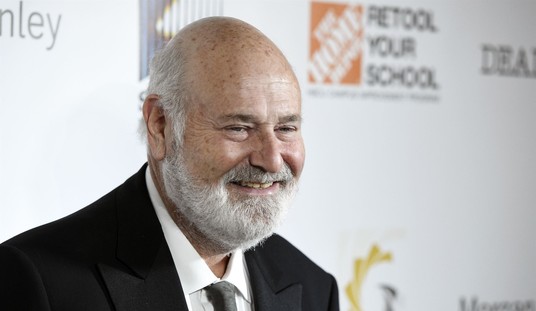Nina and I checked out 300 yesterday, and we loved it. Of course, my expectation for Hollywood couldn’t be much lower these days. My thoughts going into just about any movie theater (something I seem to be doing less and less of each year, and I’m far from alone, of course) rival what James Lileks has written about the recent trilogy of Star Wars sequels:
Just don’t suck. That’s all I ask. Suck not. As for the number of sucking, let it be zero.
300 didn’t suck.
Which is a big reason why, Nikke Finke writes, 300 “shattered the record for biggest March opening ever with $70+ million”:
It was a bloodbath at the U.S. box office this weekend. Warner Bros. told me this morning its ‘R’-rated 300 about the epic Battle of Thermopylae shattered the record for biggest March opening ever with $70+ million. (Or, $70.025 mil to be exact, though the studio didn’t provide a breakdown.) Other studios say this ‘Gladiator Gore-Fest’ raked in $27.7 mil to $28 mil Friday and $24.3 mil to $24.7 mil Saturday and an estimated $16 mil Sunday from its 3,103 theaters. Toldja so… I said back on Tuesday that 300 was tracking huge — even though most of its target audience fell asleep during that history lesson in school. But rival studios were complaining to me this weekend that the much-buzzed pic was pitched heavily to the youth market despite the R rating. (This is what gets Hollywood in trouble with Congress. In 2000, entertainment moguls had to explain to the Senate Commerce Committee, led by John McCain, why Tinseltown targets its sex and violence fare to kids.) Helped by omnipresent advertising, this CGI extravaganza was sold out even for Thursday midnight sneaks, including all 57 IMAX theaters. This pic from the creator of Sin City was cheap to make and shot in only 60 days and cast with no stars, so it ends up one of Warner’s most profitable pics. The studio’s moguls were thrilled after enduring expensive disappointment after disappointment in 2006 (Poseidon, Superman Returns, The Lake House, The Ant Bully, Lady In The Water, etc.) with the notable exceptions of Oscar winner Happy Feet from director George Miller and The Departed from Martin Scorsese. Especially with a per screen average of $9,045 Friday and $7,965 Saturday, 300 easily overtook the current record-holder for March: 2002’s Ice Age and its $46.3 mil take. That was accomplished Saturday! (FYI: Since 2006 sequel Ice Age: The Meltdown opened March 31-April 2 with $68 mil, it can’t be considered a March weekend record-holder. But 300 surged past that, too.) Though 300’s haul is amazing considering its ‘R’ rating (Ice Age was PG), it’s still not a record. The biggest R-rated pics are Matrix Reloaded at $91.7 mil in May 2003 and The Passion of the Christ at $83.8 mil in February 2004.
Of course, let’s put things into perspective: David Lean and Stanley Kubrick’s reps for grand historical epics aren’t going to be impacted by this movie, but it did its job extremely well. In fact, I was surprised that its overall look was less cartoon-like than the initial impressions from its TV promos. I was expecting much more of Sin City or Sky Captain-style actors pasted into a cartoon CGI-world, but 300’s pseudo-realism was actually much more believable than the looks of those two films. Or at least it was quickly digestable: 300’s director seems to understand something that George Lucas doesn’t:
Part of the problem with both Attack of the Clones and The Phantom Menace is that they’re so bursting with amazing images, impossible camera angles and compositions filled to bursting with movement, those images become a bit old hat. You can only be knocked out so many times that your brain stops thinking of them as amazing effects, and you start thinking “OK, this is how this corner of the universe works. This is what it looks like. This is how its technology works.” We get that it looks amazing…So get on with the story.
And 300certainly did.
Was it historically accurate? Probably more so than Gladiator, but that’s not saying much. But so what? Nobody goes to a swords and sandals movie expecting historical accuracy. Was it derivative? Well, it did feature a final shot in a wheat field that was straight out of Gladiator, and a character remarkably reminiscent of LOTR’s Gollum. But again, who doesn’t expect a Hollywood movie to not rely on other Hollywood movies for its inspirations these days. But this movie really moved–and looked incredible doing so, and that’s really all I ask of this kind of film.
As Libertas notes:
How did this one slip through? That’s all I can think of to say right now: How did this one slip through? I sat in the theatre waiting. Waiting for the switch. Though I refused to take the bait (too many movies I’ve seen, says I) I still waited for the switch. There’s always a bait and switch. You don’t make the white guys the good guys and the non-white guys the bad guys without a switch — especially bad guys in turbans. Turbans! But there was no switch. Here’s a movie about free men dying to protect freedom against tyranny — where the anti-war voices are corrupt, cowardly, dead-wrong, and politically driven — where people talk about the honor of dying for one’s country — where a strong women urges a skittish council to declare war because the enemy already has — and there’s no switch. And then to top it off: The movie’s actually good.
Ironically, “How did this one slip through?” is basically the question that I’ve asked of every big movie I’ve seen that didn’t suck since about 2003: The Passion, Narnia, the Lord of the Rings sequels. Hollywood really is at the crossroads: big films (or at least in the case of The Passion, a film about a big subject) that junk political correctness, and are infused with traditional values, and an upbeat ending, make money. Of course, this isn’t anything new–Frank Capra could have told Hollywood that 60 years ago. But then, he didn’t need to, as Mark Steynnoted in 2005:
It’s pointless to mourn for Louis B. Mayer’s lost empire. The best thing about Mr. Eyman’s book is that by bringing LB back to life he gets you thinking about all the assumptions in today’s movie business. The worst aspect is that, in dealing with Mayer’s “notorious” (i.e., perfectly unexceptional) conservatism, he can’t put aside his own assumption that somehow the creative industries ought to be politically “liberal.” The best take on that comes from Arthur Laurents, a quintessential limousine liberal and the co-author of Gypsy and West Side Story: “LB was a terrible reactionary. Very corny. He was against anything progressive…” And those terrible reactionaries made better pictures than the liberals who run Hollywood now.
Will 300 impact Hollywood? Obviously, not in the short term. With the exception of Spider-Man 3, virtually all of the innumerable trailers yesterday before 300 highlighted Hollywood’s current phase: dank, gross, low-budget nihilistic horror films, and, in a very similar genre, the latest effortby Quentin Tarantino, which featured the disgusting image of a buxom young woman whose leg is amputated and replaced with a machine gun, which she alternately walks on and fires at the baddies (baddies being a relative term in a Tarantino movie, of course) by crouching in some sort of kung fu-style pose spraying bullets upward. (No, really.)
And speaking of the Q-man, Libertas’ “Dirty Harry” notes the comparison between 300 and last year’s Sin City:
[300] had no stars, a fairly unknown director, was just another comic adaptation, and -R- rated?Sin City came from the same source material, starred Bruce Willis, Clive Owen, Josh Hartnett, Brittany Murphy, Elijah Wood, and Jessica Alba. It had a name director, and even boasted of scenes directed by Tarantino. And yet, 300 will pass Sin City’s total domestic take tomorrow.
Hopefully Hollywood is watching. 300 is successful for the very reason it’s being hammered by close-minded left-wing critics: It’s something new. It’s something refreshing. It’s about something.
It’s about heroes, honor, good versus evil, and fighting for something bigger than one’s self. It’s rousing and larger than life. It’s not just another one of those old-fashioned nuanced, nihilistic, anti-hero, thin line between-good-and-evil tired old cliched movies that have been around for decades.
And of course, if 300 wins an Oscar next year, it will be for “Best Negative Cutting” or “Best Use Of Wilhelm Scream”, even though by the time it’s done, 300’s domestic box office will leave Clooney or Gore’s next message movie far in the dust.










Join the conversation as a VIP Member